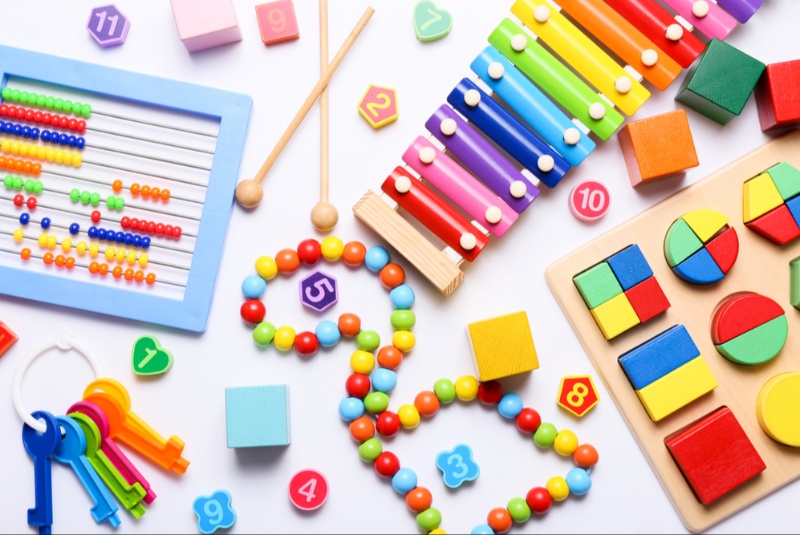As technology continues to weave its way into every aspect of our lives, educational toys for children have evolved to incorporate cutting-edge tech features. Choosing the right educational toys for tots involves more than just considering entertainment value—it's about fostering a love for learning, encouraging creativity, and ensuring the toys align with developmental milestones.
Understanding Developmental Stages: Tailoring Toys to Growth
Children go through various developmental stages, each with its own set of milestones and challenges. Educational toys should be selected with these stages in mind to provide age-appropriate stimulation. For infants, toys that focus on sensory exploration and tactile experiences are beneficial. Toddlers benefit from toys that encourage fine and gross motor skills, language development, and social interaction. Preschoolers thrive with toys that introduce basic concepts like numbers, letters, and problem-solving. Understanding your child's developmental stage ensures that the educational toys you choose contribute to their growth and learning.
Screen Time Considerations: Balancing Tech Engagement
In the era of smartphones and tablets, screen time is a prevalent concern for parents. When selecting educational toys with tech features, it's essential to strike a balance between engagement and healthy development. Choose toys that incorporate screens judiciously, promoting interactive learning rather than passive consumption. Look for options that encourage hands-on activities alongside tech engagement, fostering a well-rounded play experience. Additionally, be mindful of recommended screen time limits for different age groups and ensure that educational tech toys complement other non-screen activities.
STEM Toys: Fostering a Love for Science, Technology, Engineering, and Math
STEM (Science, Technology, Engineering, and Math) education is a priority in modern curricula, and STEM toys play a crucial role in introducing these concepts to young minds. Look for toys that engage children in hands-on exploration of STEM principles. Building blocks, coding robots, and science kits are excellent examples of STEM toys that make learning fun and interactive. Introducing STEM concepts early not only lays the foundation for academic success but also nurtures problem-solving skills and a curiosity for how the world works.
Multisensory Experiences: Engaging the Senses for Deeper Learning
Young children learn best through multisensory experiences that engage their senses of touch, sight, hearing, and sometimes even taste and smell. Educational toys that incorporate various sensory elements enhance the learning process. Consider toys with textured surfaces, vibrant colors, and interactive sound features. These multisensory experiences not only make learning more enjoyable but also strengthen neural connections, promoting a holistic understanding of different concepts.

Educational Apps and Software: Choosing Quality Over Quantity
As technology advances, many educational toys come with accompanying apps or software. When incorporating these into your child's playtime, prioritize quality over quantity. Look for apps that are age-appropriate, align with educational goals, and provide meaningful interactions. Check for apps that encourage creativity, critical thinking, and problem-solving. It's also essential to review and understand the privacy and safety features of any digital components to ensure a secure and positive learning environment.
Creativity and Imagination: Fostering Open-Ended Play
Educational toys should not only teach specific concepts but also foster creativity and imagination. Open-ended toys allow children to explore and create without strict guidelines, promoting independent thinking and problem-solving skills. Building blocks, art supplies, and imaginative playsets are examples of toys that encourage creativity. Balance structured learning with open-ended play to provide a well-rounded educational experience that nurtures a child's unique interests and talents.
Age-Appropriate Complexity: Gradual Learning Progression
Educational toys should present a level of complexity that matches a child's developmental stage while offering room for gradual learning progression. Choose toys that provide an appropriate challenge, encouraging children to expand their skills without causing frustration. For example, puzzles with varying difficulty levels, interactive books with age-appropriate content, and educational games that adapt to a child's skill level are excellent choices. Gradual learning progression ensures that educational toys remain engaging and beneficial over an extended period.
Safety First: Non-Toxic Materials and Age Ratings
When it comes to children's toys, safety is paramount. Ensure that the educational toys you choose are made from non-toxic materials that meet safety standards. Check for age-appropriate labels and adhere to recommended age ratings to guarantee that the toy aligns with your child's developmental stage. Inspect toys regularly for any signs of wear or damage and replace them if needed. Prioritizing safety ensures that educational play remains a positive and secure experience for your child.
Parental Involvement: Maximizing Educational Impact
While educational toys can provide valuable learning opportunities, parental involvement is a key factor in maximizing their educational impact. Engage with your child during playtime, ask questions, and encourage discussions about what they are learning. Take an active interest in the educational content of the toys, whether it's exploring STEM concepts, practicing language skills, or engaging in creative activities. Your involvement not only strengthens the parent-child bond but also enhances the educational benefits of the toys.
Brand Reputation and Reviews: Insights from Fellow Parents
When it comes to educational toys, the reputation of the brand and reviews from fellow parents provide valuable insights into the quality and effectiveness of different options. Established brands with a focus on educational content and child development are more likely to deliver toys that align with your expectations. User reviews offer real-world perspectives on how well the toys engage children and contribute to their learning journey. Trusting reputable brands and considering the experiences of other parents guide you in making informed decisions.
Budget Considerations: Value in Educational Investment
Educational toys come in a range of price points, and finding the right balance between features and budget is essential. Determine the educational goals you prioritize, whether it's STEM learning, creativity, or language development. While high-end educational toys may offer advanced features, there are also budget-friendly options that provide excellent educational value. Assess the long-term benefits and how well the toy aligns with your specific goals to determine its overall value in the educational investment.
Guiding Little Learners with Educational Excellence
Selecting educational toys for tots is a journey that involves understanding developmental stages, balancing tech engagement, and fostering a love for learning. With this comprehensive guide, you are equipped to make wise decisions, ensuring that educational toys contribute to the growth, creativity, and curiosity of your young learners. Nurturing young minds with educational excellence not only prepares them for academic success but also instills a lifelong love for exploration and discovery.




